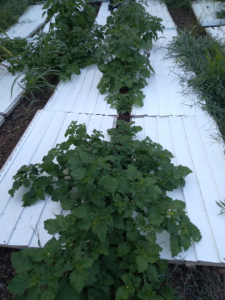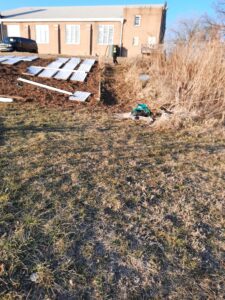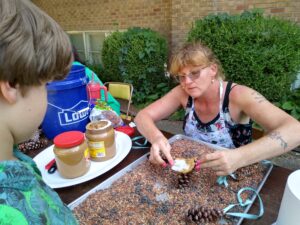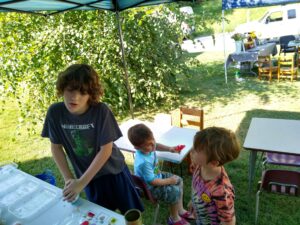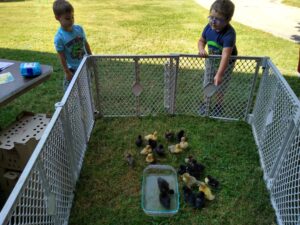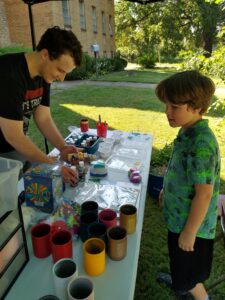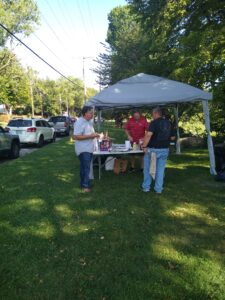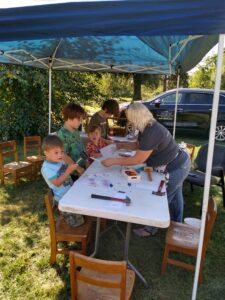Final report for FNC20-1257
Project Information
We are an urban farm working with other urban growers to maximize areas on their farm that are lacking in production due to run off, optimal growing conditions because of a slant. With growing ground cherries on a hillside we will utilize an area that is overlooked to grow on, it will help farmers not have stress on their bodies when harvesting ground cherries and it will provide the farmer with a high nutritional fruit to sell at market or for value-added products.
Our farm is sitting on 2 acres that we are growing on, farmer 2 has almost 3 acres and farmer 3 has almost 1 acre.
Ground Cherries are one of our favorite fruits to grow and eat. They are very hard to harvest since they are a low growing bush. When ripe they drop to the ground. This is a hard crop to harvest for selling at markets or to turn into added value products. We want to build a system to make harvesting easier on the grower/farmer. This is a product that is rarely available at farmers market and never seen at stores. It is a very nutritious fruit that is lacking availability due to back breaking harvesting methods. The health benefits are numerous. They are low calorie, low fat and no cholesterol. They provide a good source of niacin (B3) and Vitamins A & C. Vitamin A is good for eye sight but also believed to help fight cancer. Vitamin C protects against cold and flu, helps lower our blood pressure and protects us against Parkinson disease. The niacin (B3) in this fruit is well known for increasing the level of high density lipoprotein; HDL in our bodies, this helps reduce the incidence of heart disease. The fruit also has an abundance of pectin which helps regulate blood sugar.
2020
- Build 6 hillside garden beds -- 2 per farm.
- Built with landscape fabric, second with vinyl siding
- Weigh harvest; sell fresh or added value products, record sales.
- Have 1 tour, 1 workshop, 1 festival, 1 cooking demonstration
- Write recipes, brochures and nutritional fact sheets
- Decide design that worked and produced better.
2021
- Finish building the beds by May 15
- Start seedlings to plant 1087 transplants and 50 more
- Plant all beds with transplants by June 15
- Start measuring growth and outcomes June 15 - Oct
- Ground Cherry Festival September
- Brochures done by September 1
2021 & 2022
- Redesigned all 6 gardens to best outcome.
- Promote “Hillside Garden System” sheet and nutritional information at 3 conferences.
- Give 3 tours/workshops, 1 festival, 1 cooking demonstration.
- Weigh all the harvest from each garden, record all sales.
Cooperators
- - Producer
- - Producer
Research
We have been growing ground cherries for years and lose more production due to harvesting. They require a lot of low bending that a farmer just cannot do easily. We have tried sending our grandchildren out: they eat more than they harvest. Therefore we have only enough for jellies. Farmers are missing a huge market with this healthy fruit.
We are building a type of raised bed with treated lumber (2 x 6 boards) on the slope of a hill. This will keep everything from running off when it rains. The slopes will be 35 /40 degree. We will do a lasagna garden, no- till bed using cardboard, peat moss, leaves, top soil and mulch on top. In the 1st type of bed we laid black canvas over the beds in horizontal or vertical strips, then pinned down. We cut 3” circles for transplants and put a gutter every 3’ down the hill to catch the ground cherries.
In the 2nd type of bed we plan to lay corrugated vinyl siding that has been attached to treated 2x2 boards with 3” holes cut out for transplants. This will be laid vertically for the cherries to roll down the hill into the gutters. Put a gutter every 3’ down the hill to catch the ground cherries.
We can then easily harvest from the gutters by sweeping them to the sides. We can also keep the soil moist and weed free for low maintenance. The beds will be the same size on each farm for measured results and right next to each other. Pepper Berries farm 20' x 20', Neil Farm 16' x 16' and the Schroeder farm 6' x 8'.
We will write an instructional brochure on how to build the system, make 3 videos to share on Facebook, YouTube, share at a conference and host workshops. One will be a promotional video, the other an instructional video and the third an all-season video. We will provide nutritional information and recipes.
Initial photos of Groundcherry panel set up and bed layout:
We had to make some adjustments as we were building our 20' x 20' bed on our farm which is how the other farms will and have followed. We were planning on building everything at each farm. We ended up making all the vinyl panels in our woodshop since it got so hot out so quick this year. This was much less taxing on my farm hands. We did have to do a little bit of design change to make the panels sturdier. I was going to cut 3-inch holes in the vinyl and plant in them but they were just too flimsy so we decided upon no holes and spacing the panels 4 inches apart instead with a plastic mesh right up to the plant stem to help catch any fruit that falls there. We also used white vinyl on our farm which was hard on the eyes when the sun is out and for the other farms we bought a grey/brown color. I think this will be better for the plants to not get sunburned, easier on the glare as we work, and cooler for the plants. The system worked very well this year. I am anxious to see all 3 farms have the system and the 3 garden beds that are done with black barrier and compare the difference.
We are needing the extra time for our studies.
Educational & Outreach Activities
Participation Summary:
This year was a very hard year with Covid hanging over us. We were behind in everything from building the beds to planting and not being able to coordinate festivals or workshops. We were, however, able to give individual tours to farmers/growers and get them excited about our ground cherry production system. Several are waiting to hear our outcomes and to get the plans to build the system on their farms. With all the Covid challenges going around we had to change our farm hands especially since we had no volunteers on our farm this year. We are behind on setting up all the gardens. We will have a 6 gardens done by June 2021 for all the 1,087 ground cherry transplants to go in them.
Our 3rd farmer lost his farm this last July -- we had to make a decision that he would not be farming in 2020. This is why he never got back with you on the paperwork. He was still hoping to save the farm but he let us know in July so we did not start his project. We started looking for the 3rd farmer to work with that had a hill that would work for our system. We looked at several farmers in the area that wanted to grow ground cherries on a hillside and chose an urban farm in Kansas City, Kansas. Talking Tree Farm farmers Ashley Meek and Andrew Bertrand 860 Quindaro Blvd, KC, KS 66101 have, which is 8.2 miles from our farm. We have the supplies and will be building both garden beds in March and April, 2021. Their farm will have the smallest beds out of the 3 farms.
We will be also changing the size of these beds a little bit due to the hill and the frames that we made this summer for the beds. There garden beds will be 4.5 feet x 12 feet wide.
2022 Updates:
We really relied on Facebook to spread the word about our ground cherry festival and workshops. We did several ground cherry tours and workshops and 2 festivals. We talked with many urban farmers that were interested in seeing our end results and trying this on their hillsides to provide more product to sell at market. We went to 5 urban farms and 1 rural farm to discuss and look at how they could up-scale with this system for 2023. They all received a handout of how to build the system. We will be reaching out to them this spring with our best practices results. For the 2 festivals we were able to talk to around 125 people the first year of those there were 5 urban farmers that we went to their farms to see if the system would work for them. For the 2022 Festival we talked with about 150 people about ground cherries, passed out information sheets on the system, recipe cards and Nutritional value. We also had 2 types of ground cherry jam for them to purchase and try at the festival.
Learning Outcomes
2021 was a great year for growing ground cherries. However, we will be doing more changes in 2022. We had problems with the ground cherries rolling downhill into the gutters because of the low branches. We had to pick up the branches to get the berries to roll down. This could be due to how low they were and easily broken. Therefore, we had to stand slanted on the hill to harvest so this last season it was much harder to harvest. This year we will be mounding the growing spot up about 6 in. higher than the vinyl paneling so the branches will not be resting on the panels. We are also going to put some cattle guard fencing about 6 inches above the panels on a few rows to see if this will help keep them off the panels. We will be attaching it to a slake with a spring on it that we could hit to make the plants drop any fruit that is ready.
While building the frames for the system we had to modify them. We first drilled 3-inch holes for the plants to be planted through but this made the vinyl more flimsy so we opted out of that and started not putting in the holes and placing the panels 3 inches apart instead with a plastic mesh to catch any cherries that fall in that area. This worked well and the panels were much more sturdy. We also learned that white vinyl was not the color to choose. It made it very hard to look at through the sunniest part of the day. We chose a grey/brown color for farms 2 and 3.
We harvested a lot of ground cherries and saved them for the festival that we had in September 2021. It was a great turn out. We had around 120 participants attend, this included vendors. We had 5 craft booths put on by different groups, we had a magician perform for us, a guitarist/singer and another ukulele musician and singer. We also had a Taekwondo instructor there working with the kids. We provided Ground Cherry Cake, Ground Cherry Salsa and Ground Cherry Jam over Cream Cheese with recipes for everyone. We had popcorn, hot dogs, chips and water that the neighborhood Association provided and handed out. We also had 21 gift giveaways from business and farmers in the area to give out. We did so many tours of the education center, farm and our hillside Ground cherry system that it kept me very busy just running the tours over and over, with 2 or 3 people at a time. We talked to people that had never tried ground cherries, to urban farmers and rural farmers about the system and to gardeners that want to put some in this year.
Here are a few photo highlights from our 2021 ground cherry festival:
In 2022 we changed the system some, we added a hill between the panels and planted on them with leaves and straw around them for mulch. This put the ground cherries growth a little higher off the ground for the cherries to roll down into the gutters. They still did not work as well as we would like so next year, we will be adding a cow panel about 4 in. above the vinyl panels to keep them up more so they will be able to roll down easier. We will also be adding a spring to each corner of the panel to tap so the plants will release the fruit that are ready to drop. After trying both systems multiple ways I prefer the black canvass method for these reasons:
1. Maintenance
2. Expense
3. Result.
The black canvas worked very for weed prevention and were able to warm the ground sooner for earlier growth. It did not cost as much to build the system with and was not as fragile if you walked on it or wind blew it. We had just as good results of production using it but less labor. For the vinyl gutters it took much more time building. Some of them warped over time from exposure to sun, heat, and cold. They would blow off when we had heavy wind and storms. They would crack or break if someone accidentally step on one when maintenance checks happened or someone lost balance on the hill system, mainly me. For an older farmer/grower they were harder to maintain even though I build them for a woman to be able to handle in size. The black canvas was better all around. On the canvas we still build a raised area for the plant to grow on put the canvas alongside the raised hill with the gutters below so the cherries will roll down. This system does not require as many gutters either. Next year we will also be putting cow panels 4 in. to 6 in. above to help keep the branches from touching the ground and adding the shaker system to them.
Project Outcomes
One rural farmer in Mayview, MO started growing ground cherries in containers this year (2022) to see how they grow and taste. He never tasted them before. He will not be able to build the Hillside System on his farm because he has no hills but is excited to try growing them.
Another urban farmer in Kansas City, KS will be putting in the system on a small hillside to help control weeds and grow the ground cherries to distribute to their neighborhood.
An urban grower in Kansa City, KS has a very steep hill alongside her house that she will be putting this system in this coming spring 2023. She has already put the canvas down and is just waiting to plant and catch.
An urban grower just bought a piece of property in downtown Kansas City, MO and will be building this system for her hill next to the sidewalk for easy maintenance and nutritious food.
An urban farmer in downtown Kansas City, MO will be putting in this system with the canvas in 2023.
The black canvas was better all around. On the canvas we still build a raised area for the plant to grow on put the canvas alongside the raised hill with the gutters below so the cherries will roll down. This system does not require as many gutters either.
In 2023 we will be changing our system again. We will be removing the panels and just doing the canvas for our farm. Next year we will also be putting cow panels 4 in. to 6 in. above to help keep the branches from touching the ground and adding the shaker system to them.
